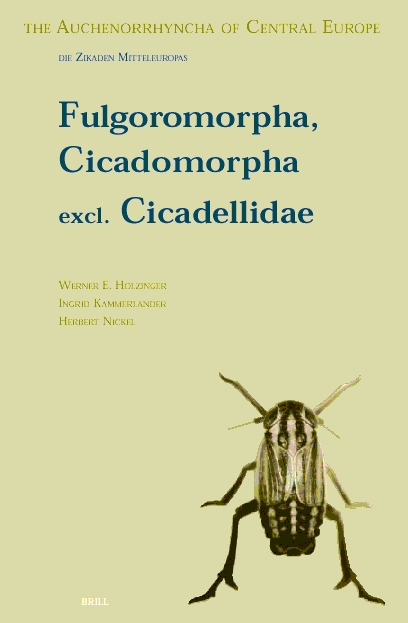 |
Holzinger, W.E., Kammerlander, I., Nickel, H. (2003): The Auchenorrhyncha of Central Europe - Die Zikaden Mitteleuropas. Volume 1: Fulgoromorpha, Cicadomorpha excl. Cicadellidae. (bilingual English / German) [published May 22nd at Brill Publishers, Leiden. 673 pp. 1566 drawings, 46 colour plates with altogether 738 photographs, 211 maps.]Poster 1 Poster 2 Subscription Sample plate 1 pdf (171 KB) Sample plate 2 pdf (173 KB) Sample plate 3 pdf (186 KB) Sample plate 4 pdf (192 KB) Sample plate 5 pdf (166 KB) Book reviews: Eur. J. Entomol. 100 (2003): 585-586 pdf (90 KB) Faun. Abh. Mus. Dresden 24 (2003): 18 pdf (38 KB) Associazione Romana di Entomologia (html) Dtsch. entomol. Z. 50 (2003): 259-260 Br. J. Ent. Nat. Hist. 18: 226-227 |
Volume I of this richly illustrated bilingual handbook The Auchenorrhyncha of Central Europe / Die Zikaden Mitteleuropas is the first identification book in this field for decades. The last keys (Melichar 1896, Haupt 1935) were compiled before major advances in genital morphology, and thus, researchers were forced to use keys of northern Europe, France, Czechia and even Ukraine. None of these, however, covered the full range of species found in central Europe.
The complete work is to be published in 3 volumes and will then comprise about 2200 pages, 5000 figures, 160 colour plates with altogether 2400 photographs and 800 maps.
The economic importance of these insects has been known for years, since many species transmit plant viruses or directly damage crops and ornamental plants. Their ecological significance, however, has long been underestimated. They occur in enormous densites in almost all terrestrial ecosystems and are an important component of many food webs.
For the first time, this new book treats all species known from 19 European countries (Iceland, Norway, Sweden, Finland, Ireland, Great Britain, Denmark, Estonia, Latvia, Lithuania, Belgium, the Netherlands, Luxemburg, Germany, Poland, Belorus, Switzerland, Austria and Czechia). It also covers adjacent regions of further 7 countries (northern parts of France, Italy, Slovenia, western parts of Hungary and Slovakia, north-western parts of Ukraine and Russia). Simple keys allow an easy identification at species level. Volume I covers about 250 species of Fulgoromorpha (planthoppers), Cicadoidea (cicadas), Cercopoidea (spittlebugs) and Membracidae (treehoppers). Relevant diagnostic features of each species are illustrated. For the first time, distribution maps and colour photographs are provided, if necessary of both sexes and different morphs. Informations on taxonomy, phenology, habitat requirements, host plants and economic importance are given in detail.
The Auchenorrhyncha of Central Europe will be a standard work of reference for many years, not only for entomologists, but also for researchers of ecology, phytopathology, applied zoology and conservation.
| CONTENTS | |
| Preface | ix |
| Acknowledgements | xiii |
| Im memoriam Frej Ossiannilsson | 1 |
| History of Auchenorrhyncha research in Central Europe | 5 |
| Biographic and bibliographic literature | 27 |
| What are planthoppers, leafhoppers and allies? | 31 |
| Diagnostic characters | 35 |
| Contents of species chapters, abbreviations | 47 |
| Sampling and collecting | 53 |
| General remarks | 53 |
| Quantitative methods | 53 |
| Semi-quantitative methods | 55 |
| Qualitative methods | 56 |
| Preparation, determination and conservation | 61 |
| Auchenorrhyncha Duméril, 1806 | 65 |
| Fulgoromorpha Evans, 1946 | 68 |
| Fam. Cixiidae Spinola, 1839 | 69 |
| Subfam. Cixiinae Spinola, 1839 | 71 |
| Tribus Oecleini Muir, 1922 | 71 |
| Tribus Cixiini Spinola, 1839 | 73 |
| Tribus Pentastirini Emeljanov, 1971 | 109 |
| Fam. Delphacidae Leach, 1865 | 131 |
| Subfam. Asiracinae Motschulsky, 1863 | 152 |
| Subfam. Kelisiinae Wagner, 1963 | 153 |
| Subfam. Stenocraninae Wagner, 1963 | 194 |
| Subfam. Delphacinae Wagner, 1963 | 199 |
| Tribus Tropidocephalini Muir, 1915 | 199 |
| Tribus Delphacini Leach, 1815 | 202 |
| Fam. Achilidae Stål, 1866 | 405 |
| Fam. Dictyopharidae Spinola, 1839 | 415 |
| Fam. Tettigometridae Germar, 1821 | 421 |
| Fam. Caliscelidae Amyot & Serville, 1834 | 433 |
| Tribus Caliscelini Fieber, 1875 | 434 |
| Tribus Ommatidiotini Fieber, 1875 | 437 |
| Fam. Issidae Spinola, 1839 | 445 |
| Tribus Issini Spinola, 1839 | 446 |
| Tribus Hysteropterini Melichar, 1906 | 461 |
| Fam. Flatidae Spinola, 1839 | 469 |
| Fam. Tropiduchidae Stål, 1866 | 473 |
| Cicadomorpha Evans, 1946 | 475 |
| Cicadoidea Westwood, 1851 | 475 |
| Fam. Cicadidae Latreille, 1802 | 475 |
| Subfam. Cicadinae Latreille, 1802 | 477 |
| Subfam. Tibicininae Distant, 1905 | 480 |
| Cercopoidea Evans, 1946 | 486 |
| Fam. Cercopidae Leach, 1815 | 487 |
| Fam. Aphrophoridae Amyot & Serville, 1843 | 491 |
| Membracoidea Rafinesque, 1815 | 523 |
| Fam. Membracidae Rafinesque, 1815 | 523 |
| Subfam. Centrotinae Amyot & Serville, 1843 | 525 |
| Subfam. Smiliinae Stål, 1869 | 529 |
| Colour plates | 531 |
| Index of German names | 627 |
| Nomenclatural changes | 639 |
| References | 643 |
| Index to genera and species | 665 |
